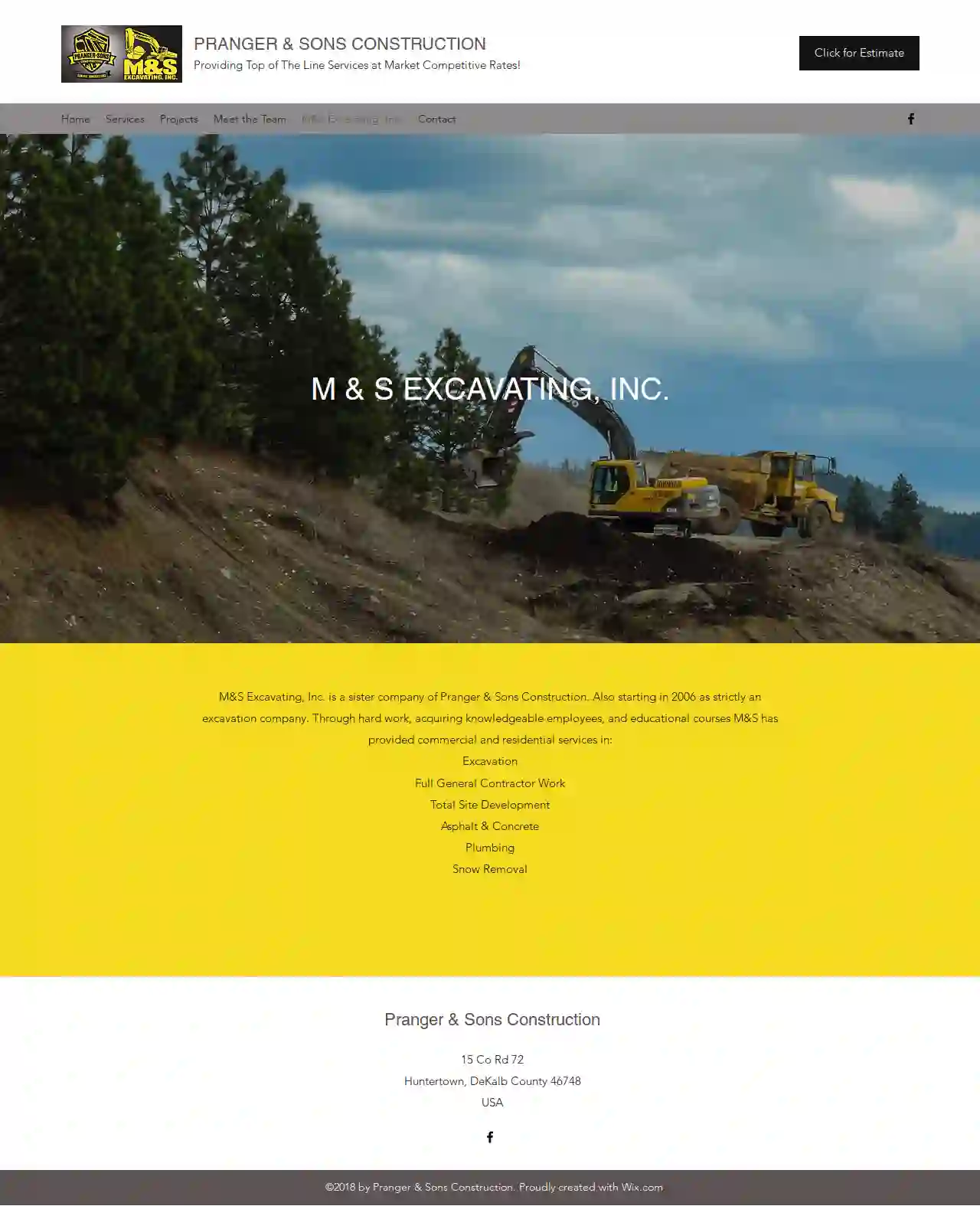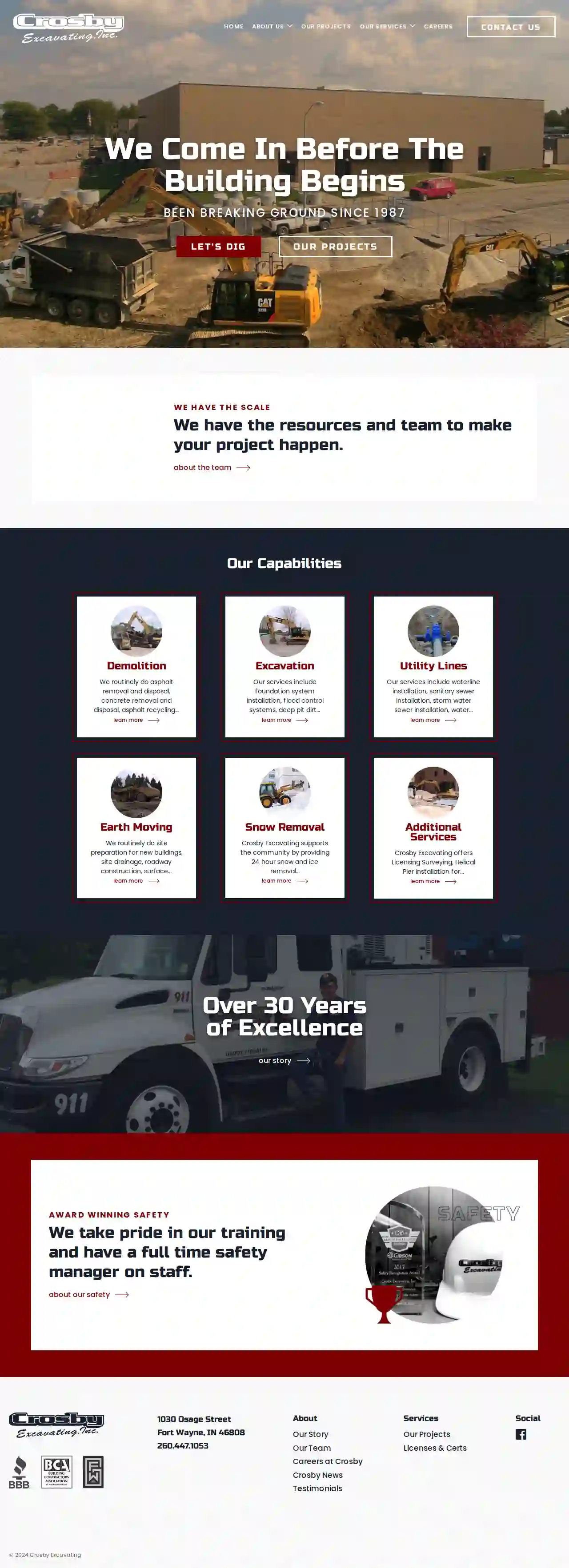Excavation Contractors Secaucus
Find Excavating Contractor in Secaucus
Receive up to 3 Excavating Contractor quotes for your project today! Compare profiles, reviews, accreditations, portfolio, etc... and choose the best deal.

Pasha Construction
275 Route 10 East Suite 220-416, Succasunna, 08786, USAbout Us Pasha Construction has been providing multidiscipline services to our Clients from our early beginnings. It has been our vast experience in all kinds of projects that have helped us find the right combination of services. As such our company is structured to provide our Clients with the services they need from early planning to final design and construction. Our corporate structure allows us to combine our resources in multiple disciplines and experience and licensed professionals, to help make your projects a reality and to deliver the projects on time and on budget. Licensed Professionals Professional Engineers Professional Architects Professional Planners Professional Land Surveyors Certified Landscape Architects Certified Professional Traffic Operations Engineers Certified Environmental Scientists Professional Geologists Certified Environmental Managers Certified Environmental Inspectors Represented Disciplines Construction Architectural Transportation Structural Civil Environmental Traffic Municipal Mechanical Site Representative Projects Construction Phase Services Architectural Designs Highway, bridge and Traffic Engineering Transportation Planning Environmental Impact assessment and Analysis Natural Resource Management Environmental Engineering Stormwater Management Land use Planning Real Estate Planning and Appraisals Master Planning Site Planning and Design Park and Recreational Facility Planning and Design Urban and Regional Planning Landscape Architecture Zoning Ordinance Preparation Software Capabilities Sewer CAD & Water Cad Microsoft Excel AutoCAD / Land Desktop Arc View GIS Societies & Organizations American Society of Civil Engineers American Institute of Certified Planners American Planning Association Institute of Transportation Engineers National Society of Professional Engineers New Jersey Society of Municipal Engineers Professional Services Pasha Construction realizes that the success of a project depends upon early planning and continual project monitoring. From initial concept and real-estate planning to final project completion, Pasha Construction is committed to providing the personnel and corporate resources required for the successful completion of the project. You can rely on our expertise and vast knowledge and experience in all types of Construction projects. Our staff is also capable of obtaining all Environmental permits from Federal, State and local government such as Flood Hazard Area, Freshwater Wetlands, Zoning and Planning Board approvals. Our goal is to make your project a success and a reality. We accomplish this by listening to the needs and goals of our clients and then providing them the knowledge and support of our professional services to guide them through all phases of the project to final approval and delivery. Total Client Service Concept At Pasha Construction, we have eliminated the need for our clients to work with a variety of firms, since our staff capabilities encompass the full range of expertise. This enables us to provide professional services for all phases of the project, in turn saving our Clients time and money. We’re thorough and efficient because we know future projects depend on getting today’s projects done on time and within budget. As part of our Total Client Service Concept, we will develop a schedule for all our projects to monitor and constantly update the project’s status so that our team members meet all milestones, deadlines and project budget in an expeditious and cost conscious manner. Our commitment to scheduling and budgeting, coupled with our multi-disciplined staff, well trained experts and advanced technical experience, will allow an immediate and timely response to our clients’ needs. We have the experience, personnel, and resources available and are ready to meet all challenges.
- Services
- Why Us?
- Gallery
Get Quote
Blackwater Draw Locality 1
4.556 reviews1500 S. Ave K, Lea Hall Room 163, Portales, 88130, USThe Blackwater Draw Museum seeks to foster preservation and education of the heritage of New Mexico, the Southern High Plains, and the greater Southwest through exhibitions, educational programs, collections, and research, while enriching and supporting the educational goals and mission of ENMU. The Blackwater Draw Museum is a small museum located on the campus of Eastern New Mexico University in Portales, New Mexico. The museum is home to a collection of artifacts from the Blackwater Draw National Historic Landmark, a site that has been inhabited by humans for over 13,500 years. The museum offers a variety of exhibits, educational programs, and research opportunities. Visitors can learn about the history of the Blackwater Draw site, the cultures that have lived there, and the archaeology of the region. The museum also has a collection of artifacts from the Casas Grandes culture, a prehistoric culture that flourished in the Southwest from about 1300 to 1450 AD. The museum is open to the public and offers a variety of tours and programs. The museum is a great place to learn about the history and culture of the Southwest. The Blackwater Draw Museum is a great place to learn about the history and culture of the Southwest. The museum offers a variety of exhibits, educational programs, and research opportunities. Visitors can learn about the history of the Blackwater Draw site, the cultures that have lived there, and the archaeology of the region. The museum also has a collection of artifacts from the Casas Grandes culture, a prehistoric culture that flourished in the Southwest from about 1300 to 1450 AD. The museum is open to the public and offers a variety of tours and programs.
- Services
- Why Us?
- Gallery
Get Quote
The New Mexico Office of Archaeological Studies
4.312 reviews7 Old Cochiti Road, Santa Fe, 87507, USAbout the Office of Archaeological Studies The New Mexico Office of Archaeological Studies (OAS) conducts archaeological research projects throughout New Mexico with a diverse group of 13 archaeologists and support staff. Our mission is to identify, interpret, and share information about prehistoric and historic sites across the state. OAS serves other State agencies and private organizations that require archaeological studies as part of their development projects. In addition, we provide ethnographic and historical research services and have an education outreach program that directly interacts with New Mexicans in order to answer their questions about archaeology, history, and the heritage of New Mexico. That program twice received the Society for American Archaeology’s Excellence in Public Education Award, in 2005 and again in 2012. In addition to client-initiated projects, OAS conducts research projects that are funded by grants and private donations. Many of the projects make use of a dedicated corps of volunteers or involve our many research associates. OAS provides training opportunities for university students and makes use of their skills in the latest technology. We also engage in educational outreach programs in surrounding states. OAS has five specialized laboratories, a research library, and a publications department. Our archaeomagnetic dating laboratory is one of two full-time laboratories in the United States that are dedicated to this dating technique and our low-energy plasma radiocarbon sampling laboratory enables us to nearly non-destructive date fragile archaeological materials. Departmental Overview The New Mexico Office of Archaeological Studies has been providing cultural resource management services throughout New Mexico since 1952. OAS continues to fulfill the Museum of New Mexico’s commitment to the highway archaeology program and has expanded to include a diverse client base. Our list of clients spans the breadth of private and public customers, yet much of the work that we have completed is for return clients. Since 1952 OAS archaeologists have conducted over 800 archaeological projects and produced nearly 1,000 reports. We have worked throughout New Mexico, adjacent states, and northern Mexico, with reports available on projects in all areas.
- Services
- Why Us?
- Gallery
Get Quote
Structure Tone LLC
56 reviewsWoodbridge, USWho We Are We are a family of companies building amazing spaces across the US, Canada, UK and Ireland. History Founded in 1971, we have grown into an organization made up of over 4,700 employees across 54 offices.
- Services
- Why Us?
- Gallery
Get Quote
M & S Excavating Inc
56 reviews15 Co Rd 72, Huntertown, 46748, USM & S EXCAVATING, INC. M&S Excavating, Inc. is a sister company of Pranger & Sons Construction. Also starting in 2006 as strictly an excavation company. Through hard work, acquiring knowledgeable employees, and educational courses M&S has provided commercial and residential services in: Excavation Full General Contractor Work Total Site Development Asphalt & Concrete Plumbing Snow Removal
- Services
- Why Us?
- Gallery
Get Quote
Short Excavating Inc.
54 reviews100 Short Line, Stratford, N0L 1N0, USAbout Short Excavating Short Excavating is a family-owned and operated business with over 20 years of experience in the excavating industry. We are committed to providing our clients with high-quality services at competitive prices. We are fully licensed and insured, and we have a team of experienced and qualified professionals who are dedicated to exceeding your expectations. We offer a wide range of excavating services, including: Site preparation Grading Demolition Foundation work Utility installation And more! We are committed to providing our clients with the highest level of customer service. We are always available to answer your questions and address your concerns. We are also committed to working with you to ensure that your project is completed on time and within budget. Contact us today for a free estimate!
- Services
- Why Us?
Get Quote
Niblock Excavating
11 reviews906 Maple St, Bristol, 46507, USFull Service. Family Run. Formidable Capabilities. For over seven decades, Niblock has been delivering top-notch earthwork, underground utility work and paving in Northern Indiana and Southern Michigan. With a crew over 100 strong, we handle all facets of large civil work while offering the efficient communication and personalized service of a family run company. The Niblock Difference Done Right the First Time, Every Time It’s a cliche claim, but no less true. We hold ourselves to the highest standards in all we do. In fact, we’ve actually turned down work when specifications don’t meet our standards. When you choose Niblock, you can count on long term durability. More than Muscle, Experienced Problem-solving Partners With decades of experience, we’ve seen it all. We’re always on the lookout for ways to improve performance and make your application more efficient. We’ve helped clients reroute access and layout for better traffic flow, spotted ways to improve drainage, dramatically expand capacity with minor alterations, and more. Tightly Coordinated, Family Run We pack big capabilities into a small-company feel, enabling us to communicate more efficiently and eliminate approval bottlenecks. You’ll get personalized service and a simple, single point of contact for all of your job needs. On Time and On Budget It seems delays and overruns are standard operating procedure for many, but not at Niblock. We’re experienced and realistic in our projections. We pride ourselves on sticking to our budget and deadline commitments. A Steady History You can Count On For three generations, Niblock has been delivering top-notch work in Northern Indiana and Southern Michigan. We have a stable, long-term track record. When we say we stand by our work, you can be assured we’ll be here to do just that for many years to come.
- Services
- Why Us?
- Gallery
Get Quote
Custom Sheds Plus
52 reviews3008 Lower Huntington Road, Fort Wayne, 46809, USCUSTOM SHEDS PLUS She Shed, Tiny Home, Mancave, Lake Shed, Cigar/Bar Shed, Garden Shed, Tool Shed, Storage Shed, you dream it we can make it. Create your custom shed with us and turn your dream a reality! Call us to create your very own She Shed, Mancave, Lake Shed, Cigar/Bar Shed, Garden Shed, or Tool Shed! We build custom storage barns, play houses, or anything you can think of. You create it, we will build it! We also have pre-made inventory at 3 different lot locations that you can visit. Our goal is to provide a structure that exceeds your expectations!
- Services
- Why Us?
- Gallery
Get Quote
New Jersey One Call
2.952 reviews1 Corporate Place South, Suite 150, Piscataway, 08854, USWelcome to New Jersey One Call If you’re digging in New Jersey and you need to know what’s below, please review the following process to ensure a safe excavation experience. Digging can be a dangerous activity. Everyone must take steps to protect underground utilities and avoid interruption of vital services, property damage and possible injury. Take the following steps every time you dig to avoid damages and prevent expensive repairs, project delays and costly fines. How It Works New Jersey Law requires anyone digging to call at least three full business days (excluding weekends and holidays) prior to beginning work. This includes excavators as well as property and home owners’ contractors. Contact New Jersey One Call at 811 or 800-272-1000 any time, day or night, and follow these steps: WAIT for the site to be marked with paint, flags or stakes. See what colors each utility company uses. RESPECT THE MARKS DIG WITH CARE by hand digging within two feet on either side of any marked facility.
- Services
- Why Us?
- Gallery
Get Quote
Crosby Excavating Inc
3.515 reviews1030 Osage St, Fort Wayne, 46808, USYesterday and Today One man, one truck and a vision. In 1987, our founder, Steve Crosby, had a vision, and a passion. Steve had been raised in a “construction family”. Steve’s father worked for a local construction company, and encouraged Steve to tag along with him as he went to construction sites throughout the region. It was only natural that Steve would enter the construction industry when he began his own career. Thirty-five years later, he is still here. Steve loved trucking, and moving dirt. He started Crosby Excavating very humbly, with a single dump truck. Against all odds, and through sheer determination and dedication, Steve’s little company began to take shape. One truck led to two, then his first employee, and the die was cast. Crosby’s fleet of trucks grew, as did the type and size of equipment. Today Crosby Excavating operates from its renovated facility at 1030 Osage Street, near downtown Fort Wayne. The four acre site also includes a fully staffed maintenance shop and covered equipment storage area. As a result of its focus on quality, on time performance, and cost effective pricing, Crosby Excavating is enjoying steady growth in all of its market segments. This growth has allowed Crosby Excavating to attract the best talent in the region, making Team Crosby the envy of the industry. In order to keep up with the demand for its services, Crosby Excavating has been acquiring new and more efficient capital equipment. Whether it’s pavement demolition, earth moving, excavation, or snow removal, Crosby has the right piece of equipment to do the job. No job is too large or too complex for Crosby Excavating. In 2013 Crosby Excavating grew 93 percent when compared to 2012. Growth continues at an impressive rate, in all areas of its business. This growth is the result of Crosby’s core principles: Safety first Do it right the first time Do it on time Provide unsurpassed value to our clients Crosby Excavating has been providing total site development services since 1987. It has never failed to complete a contract, and stands ready to perform for you. Our Mission We strive to maintain the highest degree of technology in the industry, so that we can offer our customers the best solutions to their needs. All Crosby Excavating employees are dedicated to the understanding that our customers are the most important people. Our customers are NOT dependent on us….we are dependent on them. Our company will continue to thrive and grow by maintaining our mission and our commitment to our customers. Award Winning Safety We take pride in our training and have a full time safety manager on staff.
- Services
- Why Us?
- Testimonials
- Gallery
Get Quote
Over 22,076+ Excavation Contractors registered
Our excavation companies operate in Secaucus & surroundings!
ExcavationHQ has curated and vetted the Best Excavation Pros in and around Secaucus. Find the most trustworthy contractor today.
Frequently Asked Questions About Excavation Contractors
- Utility Locates: Contact your utility companies to mark the locations of underground lines before excavation begins. This is usually a free service.
- Hand Digging: Excavate carefully by hand near marked utility lines to avoid damage.
- Potholing: Digging small test holes to expose and verify utility depths and locations.
- Safe Distances: Maintaining a safe distance between excavation equipment and marked utility lines.
- Vacuum Excavation: Using vacuum excavation techniques to expose utilities without digging, reducing the risk of damage.
- Soil Type and Stability: Stable, cohesive soils allow for deeper excavations than loose or unstable soils.
- Groundwater Level: Excavations below the water table require dewatering techniques to manage water intrusion.
- Equipment and Resources: The size and capabilities of excavation equipment influence the achievable depth.
- Safety Regulations: OSHA and other safety regulations impose limitations on trench depths without proper shoring or sloping.
- Project Requirements: The purpose of the excavation (basement, pool, foundation) determines the necessary depth.
- Spring and Fall: Often considered favorable due to moderate temperatures and drier soil conditions.
- Summer: Can be suitable, but hot weather can make working conditions challenging and might require additional measures (shade, hydration) for workers.
- Winter: Excavation in winter can be more difficult due to frozen ground, snow, and potential delays caused by inclement weather. It might also require specialized equipment or techniques.
How do you protect utilities during excavation?
How deep can you excavate?
What is the difference between cut and fill excavation?
Cut: Involves excavating soil from an area where the existing grade is higher than the desired grade.
Fill: Refers to using the excavated soil ('cut' material) to raise the grade in an area where the existing grade is lower than desired.
This method minimizes the need to import or export soil, reducing costs and environmental impact. It's commonly used for site preparation, road construction, and landscaping.
What is the best time of year for excavation?
How do you protect utilities during excavation?
- Utility Locates: Contact your utility companies to mark the locations of underground lines before excavation begins. This is usually a free service.
- Hand Digging: Excavate carefully by hand near marked utility lines to avoid damage.
- Potholing: Digging small test holes to expose and verify utility depths and locations.
- Safe Distances: Maintaining a safe distance between excavation equipment and marked utility lines.
- Vacuum Excavation: Using vacuum excavation techniques to expose utilities without digging, reducing the risk of damage.
How deep can you excavate?
- Soil Type and Stability: Stable, cohesive soils allow for deeper excavations than loose or unstable soils.
- Groundwater Level: Excavations below the water table require dewatering techniques to manage water intrusion.
- Equipment and Resources: The size and capabilities of excavation equipment influence the achievable depth.
- Safety Regulations: OSHA and other safety regulations impose limitations on trench depths without proper shoring or sloping.
- Project Requirements: The purpose of the excavation (basement, pool, foundation) determines the necessary depth.
What is the difference between cut and fill excavation?
Cut: Involves excavating soil from an area where the existing grade is higher than the desired grade.
Fill: Refers to using the excavated soil ('cut' material) to raise the grade in an area where the existing grade is lower than desired.
This method minimizes the need to import or export soil, reducing costs and environmental impact. It's commonly used for site preparation, road construction, and landscaping.
What is the best time of year for excavation?
- Spring and Fall: Often considered favorable due to moderate temperatures and drier soil conditions.
- Summer: Can be suitable, but hot weather can make working conditions challenging and might require additional measures (shade, hydration) for workers.
- Winter: Excavation in winter can be more difficult due to frozen ground, snow, and potential delays caused by inclement weather. It might also require specialized equipment or techniques.